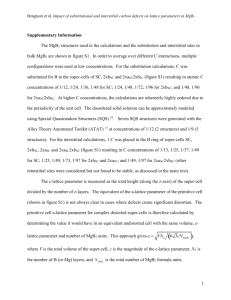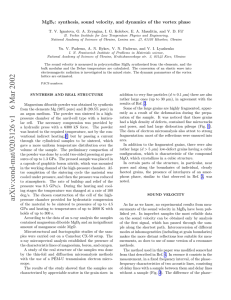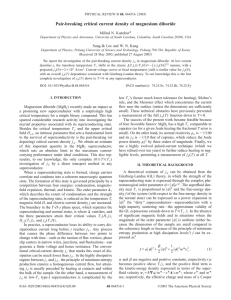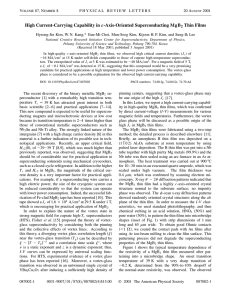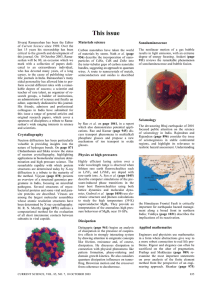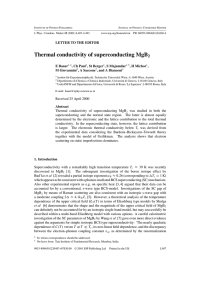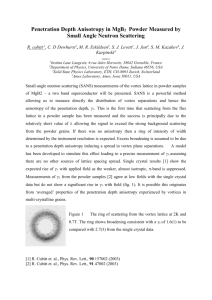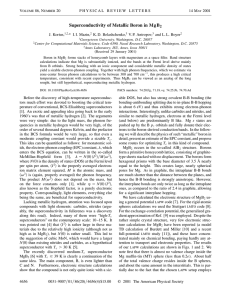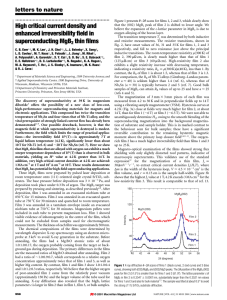Electrical transport and anisotropic superconducting properties in single crystalline
advertisement
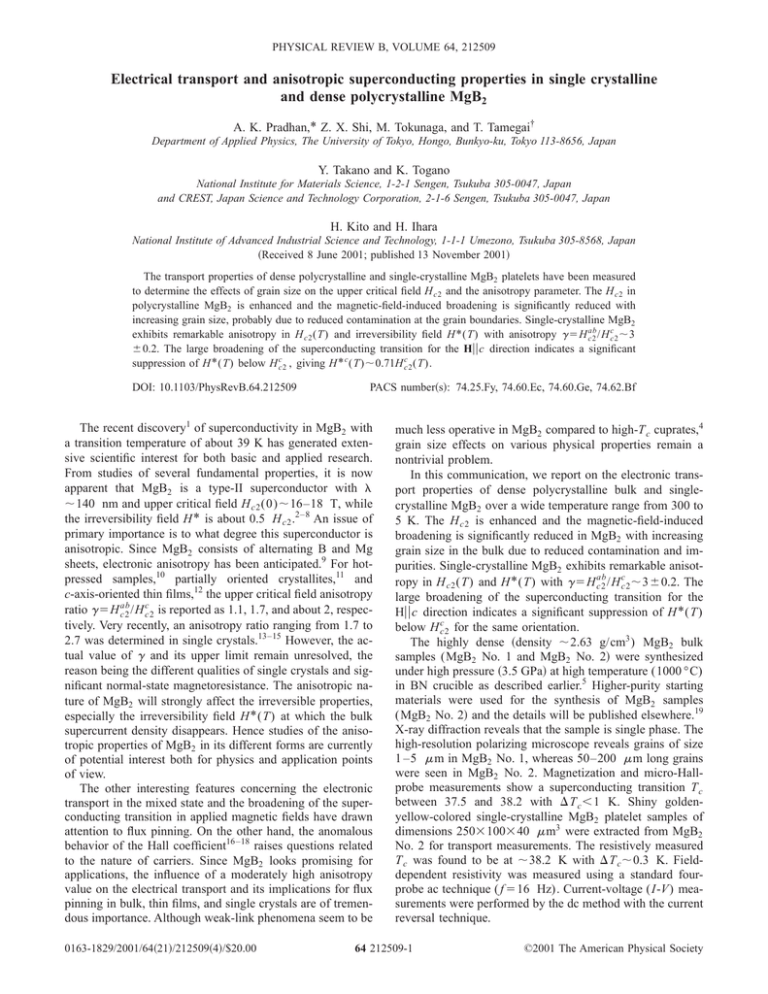
PHYSICAL REVIEW B, VOLUME 64, 212509 Electrical transport and anisotropic superconducting properties in single crystalline and dense polycrystalline MgB2 A. K. Pradhan,* Z. X. Shi, M. Tokunaga, and T. Tamegai† Department of Applied Physics, The University of Tokyo, Hongo, Bunkyo-ku, Tokyo 113-8656, Japan Y. Takano and K. Togano National Institute for Materials Science, 1-2-1 Sengen, Tsukuba 305-0047, Japan and CREST, Japan Science and Technology Corporation, 2-1-6 Sengen, Tsukuba 305-0047, Japan H. Kito and H. Ihara National Institute of Advanced Industrial Science and Technology, 1-1-1 Umezono, Tsukuba 305-8568, Japan 共Received 8 June 2001; published 13 November 2001兲 The transport properties of dense polycrystalline and single-crystalline MgB2 platelets have been measured to determine the effects of grain size on the upper critical field H c2 and the anisotropy parameter. The H c2 in polycrystalline MgB2 is enhanced and the magnetic-field-induced broadening is significantly reduced with increasing grain size, probably due to reduced contamination at the grain boundaries. Single-crystalline MgB2 c exhibits remarkable anisotropy in H c2 (T) and irreversibility field H * (T) with anisotropy ␥ ⫽H ab c2 /H c2 ⬃3 ⫾0.2. The large broadening of the superconducting transition for the H兩兩 c direction indicates a significant suppression of H * (T) below H cc2 , giving H * c (T)⬃0.71H cc2 (T). DOI: 10.1103/PhysRevB.64.212509 PACS number共s兲: 74.25.Fy, 74.60.Ec, 74.60.Ge, 74.62.Bf The recent discovery1 of superconductivity in MgB2 with a transition temperature of about 39 K has generated extensive scientific interest for both basic and applied research. From studies of several fundamental properties, it is now apparent that MgB2 is a type-II superconductor with ⬃140 nm and upper critical field H c2 (0)⬃16–18 T, while the irreversibility field H * is about 0.5 H c2 .2– 8 An issue of primary importance is to what degree this superconductor is anisotropic. Since MgB2 consists of alternating B and Mg sheets, electronic anisotropy has been anticipated.9 For hotpressed samples,10 partially oriented crystallites,11 and c-axis-oriented thin films,12 the upper critical field anisotropy ab c /H c2 is reported as 1.1, 1.7, and about 2, respecratio ␥ ⫽H c2 tively. Very recently, an anisotropy ratio ranging from 1.7 to 2.7 was determined in single crystals.13–15 However, the actual value of ␥ and its upper limit remain unresolved, the reason being the different qualities of single crystals and significant normal-state magnetoresistance. The anisotropic nature of MgB2 will strongly affect the irreversible properties, especially the irreversibility field H * (T) at which the bulk supercurrent density disappears. Hence studies of the anisotropic properties of MgB2 in its different forms are currently of potential interest both for physics and application points of view. The other interesting features concerning the electronic transport in the mixed state and the broadening of the superconducting transition in applied magnetic fields have drawn attention to flux pinning. On the other hand, the anomalous behavior of the Hall coefficient16 –18 raises questions related to the nature of carriers. Since MgB2 looks promising for applications, the influence of a moderately high anisotropy value on the electrical transport and its implications for flux pinning in bulk, thin films, and single crystals are of tremendous importance. Although weak-link phenomena seem to be 0163-1829/2001/64共21兲/212509共4兲/$20.00 much less operative in MgB2 compared to high-T c cuprates,4 grain size effects on various physical properties remain a nontrivial problem. In this communication, we report on the electronic transport properties of dense polycrystalline bulk and singlecrystalline MgB2 over a wide temperature range from 300 to 5 K. The H c2 is enhanced and the magnetic-field-induced broadening is significantly reduced in MgB2 with increasing grain size in the bulk due to reduced contamination and impurities. Single-crystalline MgB2 exhibits remarkable anisotab c /H c2 ⬃3⫾0.2. The ropy in H c2 (T) and H * (T) with ␥ ⫽H c2 large broadening of the superconducting transition for the H兩兩 c direction indicates a significant suppression of H * (T) c for the same orientation. below H c2 The highly dense 共density ⬃2.63 g/cm3 ) MgB2 bulk samples (MgB2 No. 1 and MgB2 No. 2兲 were synthesized under high pressure 共3.5 GPa兲 at high temperature (1000 °C) in BN crucible as described earlier.5 Higher-purity starting materials were used for the synthesis of MgB2 samples (MgB2 No. 2兲 and the details will be published elsewhere.19 X-ray diffraction reveals that the sample is single phase. The high-resolution polarizing microscope reveals grains of size 1 –5 m in MgB2 No. 1, whereas 50–200 m long grains were seen in MgB2 No. 2. Magnetization and micro-Hallprobe measurements show a superconducting transition T c between 37.5 and 38.2 with ⌬T c ⬍1 K. Shiny goldenyellow-colored single-crystalline MgB2 platelet samples of dimensions 250⫻100⫻40 m3 were extracted from MgB2 No. 2 for transport measurements. The resistively measured T c was found to be at ⬃38.2 K with ⌬T c ⬃0.3 K. Fielddependent resistivity was measured using a standard fourprobe ac technique ( f ⫽16 Hz). Current-voltage (I-V) measurements were performed by the dc method with the current reversal technique. 64 212509-1 ©2001 The American Physical Society BRIEF REPORTS PHYSICAL REVIEW B 64 212509 FIG. 1. Temperature-dependent electrical resistivity of 共a兲 MgB2 No. 1 and 共b兲 MgB2 No. 2 in both perpendicular 共solid lines兲 and parallel fields 共dashed lines兲 H⫽0, 1, 2, 3, 4, 5, 6, 7, 8, and 9 T 共right to left兲, respectively. The inset in 共a兲 shows the temperature dependence of the normal-state resistivity of MgB2 No. 1 for H⫽0 T. The inset in 共b兲 shows the temperature dependence of the Hall coefficient of MgB2 No. 2. First, we discuss the behavior of field-induced resistive transitions in MgB2 No. 1 and No. 2. In Fig. 1 we present the resistive superconducting transition in MgB2 No. 1 and MgB2 No. 2 under both perpendicular 共solid lines兲 and parallel 共dashed lines兲 magnetic fields, both perpendicular to the current flow, up to 9 T. The temperature-dependent electrical resistivity of MgB2 No. 1, shown in the inset of Fig. 1共a兲, roughly obeys the power law ⫽ 0 ⫹ 1 T ␣ with ␣ ⬃1.9, in the normal state. Similar behavior with ␣ ⬃2.1 was found in MgB2 No. 2. The resistivity (40 K)⬃41.7 ⍀ cm in MgB2 No. 1 is reduced to ⬃32.1 ⍀ cm for MgB2 No. 2. The magnetotransport results show two significant differences between two types of samples. In MgB2 No. 1, there is a large broadening in resistivity under magnetic field with a pronounced tail feature, indicating a considerable flux-flow phenomenon observed in sintered MgB2 bulk.2 This behavior is strongly reduced in MgB2 No. 2, as a consequence, both H c2 and H * are enhanced. Note that the magnetic critical current density in MgB2 No. 2 is enhanced by an order of magnitude (⬃1⫻104 A/cm2 ) at 5 K in a field of 5 T compared to that of MgB2 No. 1. Although weak links are the primary suspects of such a large resistive broadening, contamination due to foreign atoms might play a major role. No significant anisotropy was observed in both samples as shown in Fig. 1 for two field orientations, which is consistent with a random orientation of each grain in the polycrystalline pellets. In the inset of Fig. 1共b兲, we show the temperature dependence of the Hall coefficient R H of MgB2 No. 2, calculated under magnetic field reversal (H⫽⫾5 T) at a given temperature. R H is positive over the whole temperature range FIG. 2. Temperature dependence of the in-plane resistivity at various magnetic fields 共a兲 up to 4 T for H兩兩 c axis, 共b兲 for H兩兩 ab at H⫽0,1,2,3,4,5,7,9 T in a MgB2 single-crystalline sample. The upper inset in 共b兲 shows the temperature dependence of the normal state resistivity for H⫽0 T. The lower inset in 共b兲 shows the temperature dependence of the resistivity near the transition. and is weakly temperature dependent. R H shows a peak around T c before going to zero without any sign change anomaly. This is consistent with the recent report on thin film17 rather than that for a polycrystalline sample.16 The estimated hole carrier density ⬃1.84⫻1023 holes/cm3 at 300 K is rather high and needs its explanation using a twoband model; however, it is consistent with the low resistivity observed in MgB2 . We estimate the mean free path at the lowest temperature l⫽90 nm from l⫽3/关 N(0) v F e 2 兴 , where is the residual resistivity, N共0兲 is the density of states at the Fermi level, v F is the Fermi velocity, and e is the elementary charge. Here we used N(0) ⫽0.7 states/(eV cell) from specific heat measurement,20 and v F ⫽4.8⫻107 cm/sec from band structure calculations.21 The coherence length without impurity is given by 0 ⬃0.18ប v F /k B T c and is estimated as 17 nm. With these estimations, we can safely claim that our MgB2 single crystal is in the clean limit l/ 0 ⬎1. Figure 2 shows the main results of this paper. The temperature-dependent resistivity curves are shown for fixed field values applied in both the 共a兲 H兩兩 c and 共b兲 H兩兩 ab planes of the MgB2 single-crystalline sample. The estimated resistivity ratio (300 K)/ (40 K) is ⬃5.5 with (40 K) ⬃1.8 ⍀ cm. This value is much smaller than our polycrystalline samples, but similar to the results on single crystals.13–15 The temperature dependence of the resistivity in zero field shown as an inset in Fig. 2共b兲 roughly obeys a ⫽ 0 ⫹ 1 T ␣ power law with ␣ ⬃3 in the normal state and is consistent with a previous report.2 A sharp T c at ⬃38.2 K with ⌬T c ⬍0.3 K indicates the high quality and homogeneity of the crystal. Although T c of the present crystal is slightly lower than that of bulk1 and wires,6 it is very similar 212509-2 BRIEF REPORTS PHYSICAL REVIEW B 64 212509 FIG. 3. Temperature dependence of the upper critical fields H c2 and irreversibility fields H * of 共a兲 MgB2 No. 1 and MgB2 No. 2, and 共b兲 single-crystalline MgB2 . to single-crystal results.13–15 The origin of a lower T c in single crystals may be related to unavoidable contamination by impurities from the BN 共Refs. 5 and 15兲 containers, when using cubic anvil and Mo 共Ref. 13兲 or Nb 共Ref. 14兲 in other cases. The resistive transition under magnetic field for H兩兩 c is significantly suppressed compared to that for H兩兩 ab. In addition, the significant broadening of the transition for H兩兩 c causes a large suppression of H * c . Interestingly, the transition remains very sharp for the H兩兩 ab plane, indicating a moderately large upper critical field anisotropy in the system. Figure 3 shows in detail the resistively determined H c2 (T) and H * (T) lines for dense pellets and single-crystalline MgB2 samples. H * (T) defined with a criterion of ⫽0.01 ⍀ cm is shown in Fig. 2共a兲 as arrows. Thus determined H * (T) roughly coincides with that determined from magnetic measurements with a critical current criterion of J c ⫽100 A/cm2 . It is clear that both H c2 (T) and H * (T) in MgB2 No. 2 are higher than that of MgB2 No. 1. The suppression of H * (T) is remarkably smaller in MgB2 No. 2, indicating reduced flux flow and weaker vortex fluctuations. In MgB2 No. 2, H * occurs at H * (T)⬃0.72H c2 (T) which is larger than that of 0.66 estimated for MgB2 No. 1. The higher H c2 values obtained in MgB2 No. 2 can have several reasons. Consider a sample of randomly oriented grains of a uniaxial superconab c /H c2 placed in a field along z. ductor with anisotropy ␥ ⫽H c2 The distribution of grains over their c direction is given by dN⫽N sin d/2 with being the angle between the c axis and the applied field H. It is certain that the upper critical field of the grains depends on according to22 H c2 ( ) ab ⫽Hc2 /⑀()1/2 with ⑀ ( )⫽1⫹( ␥ 2 ⫺1)cos2. In the absence of any anisotropy in H c2 in both bulk samples, the observed H c2 is rather due to the average effects of all grains than any preferential grain orientations. This shows a lack of texturing in both bulk samples. One of the major dominating effects on both H c2 and H * is due to impurities. The presence of a small amount of MgO and MgB4 at grain boundaries in MgB2 No. 1 共Ref. 8兲 may be one of the reasons for reduced H c2 and H * and enhanced dissipation. In contrast, MgB2 No. 2 has large grain size and is free from such disorders. Impurities enhance carrier scattering and reduce the mean free path l. Since H c2 ⬀⌽ 0 / 2 and is related to l as 1/ ⫽1/l⫹1/ 0 , where ⌽ 0 is the flux quantum and 0 is the coherence length without impurities, one can argue that a reduction of l by impurities should enhance H c2 , which is contrary to what we observed. Hence we speculate that impurities in MgB2 No. 1 are mainly localized near the grain boundaries and affect intergranular transport. They may also be a limiting factor for grain growth. Alternatively, atomic disorder inside the grain may be another reason for the enhancement of both H * and the critical current density as recently found in MgB2 upon proton irradiation.23 In the MgB2 single-crystalline sample 关shown in Fig. 3共b兲兴, it is immediately clear that there is a remarkable anisotropy in the upper critical fields with anisotropy ratio ␥ FIG. 4. Current-voltage (I⫺V) curves of 共a兲 MgB2 No. 2 for H⫽5 T in the temperature range 26.5–25.3 K 共0.2 K step兲 and 25.3–23.3 K 共0.5 K step兲 and 共b兲 MgB2 crystal for H⫽2 T applied parallel to the ab plane within the temperature range between 33.7 K and 32.1 K 共0.2 K step兲. The inset in 共b兲 shows the temperature dependence of d /dT for H兩兩 ab⫽2 T, showing a sharp transition. 212509-3 BRIEF REPORTS PHYSICAL REVIEW B 64 212509 ab c ⫽Hc2 /Hc2⬃3⫾0.2, which is larger than the reported values,11–15 but smaller than the estimation by CESR,22 ␥ ⫽6 –9. A significant suppression of the irreversibility field c (T), which is H * occurs for H兩兩 c, giving H * c (T)⬃0.71H c2 15 larger than that of the recent report of H * c (T) c ⬃0.5H c2 (T). This is mainly due to the single resistive transition observed in the present crystal for H兩兩 c. By contrast, ab (T). The H * c (T) is for H兩兩 ab we found H * ab (T)⬃0.91H c2 also suppressed in comparison to the H irr determined magc (T)/dT netically in a sintered sample.2 We evaluated dH c2 ab ⬃⫺0.17 T/K and dH c2 (T)/dT⬃⫺0.55 T/K in the higherfield region in order to avoid the region of small positive curvature at low fields and to exclude any contribution from the minority phase. In addition, we mention that a small positive curvature in H c2 near T c may also support that MgB2 is a clean-limit superconductor like intermetallic borocarbides.24 Assuming the extrapolation formula for H c2 (0) an isotropic s-wave superconductor,9 c (0)⬃4.8 T ⫽0.73T c 关 ⫺dH c2 (T)/dT 兴 , we estimated H c2 ab (0)⬃15 T, giving ␥ ⬃3.2. The simple extrapolation and H c2 c ab of H c2 and H c2 lines to the zero-temperature axis yields c ab H c2 (0)⬃6.5 T and H c2 (0)⬃20.5 T. Using the anisotropic c 2 (0)⫽⌽ 0 /(2 ab ) and Ginzburg-Landau 共GL兲 equations H c2 ab H c2 (0)⫽⌽ 0 /(2 ab c ), the GL coherence lengths c (0) and ab (0) are estimated to be ⬃2.7 nm for H兩兩 c and ⬃8.2 nm for H兩兩 ab. Hence, we can conclude that MgB2 shows a moderate anisotropy that is between intermetallic borocarbides (⬃1.13) and YBa2 Cu3 O7 (⬃6). Finally, in Fig. 4 we present the isothermal I-V curves for 共a兲 MgB2 No. 2 at H⫽5 T and 共b兲 single-crystalline MgB2 at H⫽2 T applied parallel to the ab plane. MgB2 No. 2 shows I-V curves similar to the recent report on MgB2 films25 and YBa2 Cu3 O7 , and can be consistently explained *Permanent address: Jesse W. Beams Laboratory of Physics, University of Virginia, Charlottesville, VA 22901. † Corresponding author. Email address: tamegai@ap.t.u-tokyo.ac.jp 1 J. Nagamatsu et al., Nature 共London兲 410, 63 共2001兲. 2 D.K. Finnemore et al., Phys. Rev. Lett. 86, 2420 共2001兲. 3 S.L. Bud’ko et al., Phys. Rev. Lett. 86, 1877 共2001兲. 4 D.C. Larbalestier et al., Nature 共London兲 410, 186 共2001兲. 5 Y. Takano et al., Appl. Phys. Lett. 78, 2914 共2001兲. 6 P.C. Canfield et al., Phys. Rev. Lett. 86, 2423 共2001兲. 7 H.H. Wen et al., Physica C 363, 170 共2001兲. 8 G. Fuchs et al., Solid State Commun. 118, 497 共2001兲. 9 H. Haas and K. Maki, cond-mat/0104207 共unpublished兲. 10 A. Handstein et al., J. Alloys Compd. 329, 285 共2001兲. 11 O.F. de Lima et al., Phys. Rev. Lett. 86, 5974 共2001兲. 12 S. Patnaik et al., Supercond. Sci. Technol. 14, 315 共2001兲. 13 M. Xu et al., Appl. Phys. Lett. 79, 2779 共2001兲. 14 C.U. Jung, Jae-Hyuk Choi, P. Chowdhury, Kijoon H.P. Kim, MinSeok Park, Heon-Jung Kim, J.Y. Kim, Zhonglian Du, Mun-Seog Kim, W.N. Kang, Sung-Ik Lee, Gun Yong Sung, and Jeong Yong using vortex-glass theory.26 However, a scaling analysis of the vortex state is beyond the scope of the present paper. In Fig. 4共b兲 we show a remarkably different behavior of I-V curves in single-crystalline MgB2 for H兩兩 ab. The sudden change of the curvature may indicate a first-order-like vortex-lattice melting transition for this field orientation. The temperature dependence of d /dT for H兩兩 ab at 2 T shown in the inset of Fig. 4共b兲 exhibits a sharp peak, suggesting the phenomenon of melting. The transition becomes broader for higher fields possibly due to the dominant effect of disorder. The transition was found to be very weakly current dependent. It is worth mentioning that a similar sudden change of slope is observed in the same crystal in low fields, H ⬍1 T, for the H兩兩 c direction. This is consistent with the vortex-lattice melting transitions generally observed in untwined YBa2 Cu3 O7 crystals.27. However, further thermodynamic evidence is necessary to support this claim. In summary, our transport results show that H c2 is enhanced and the magnetic-field-induced broadening is significantly reduced in the large-grain polycrystalline bulk MgB2 sample. Single-crystalline MgB2 exhibits remarkable anisotab c /H c2 ⬃3⫾0.2. The ropy in H c2 (T) and H * (T) with ␥ ⫽H c2 large broadening of the superconducting transition for H兩兩 c direction indicates a significant suppression of H * (T) below c for the same orientation. The sharp resistive transition H c2 and the sudden change of slope in I-V curves indicate the possibility of a first-order vortex-lattice melting like transition. These results could be very important to understand the mechanism of superconductivity in MgB2 and useful for technological advances. This work was supported by a Grant-in-aid for Scientific Research from the Ministry of Education, Culture, Sports, Science and Technology. Lee, cond-mat/0105330 共unpublished兲. S. Lee et al., J. Phys. Soc. Jpn. 70, 2255 共2001兲. 16 W.N. Kang et al., Appl. Phys. Lett. 79, 982 共2001兲. 17 W.N. Kang, Hyeong-Jin Kim, Eun-Mi Choi, Kijoon H.P. Kim, and Sung-Ik Lee, cond-mat/0105024 共unpublished兲. 18 R. Jin, M. Paranthaman, H.Y. Zhai, H.M. Christen, D.K. Christen, and D. Mandrus, cond-mat/0104411 共unpublished兲. 19 Y. Takano, H. Takeya, H. Fujii, H. Kumakura, T. Hatano, K. Togano, H. Kito, and H. Ihara 共unpublished兲. 20 F. Bouquet et al., Phys. Rev. Lett. 87, 047001 共2001兲. 21 J. Kortus et al., Phys. Rev. Lett. 86, 4656 共2001兲. 22 F. Simon et al., Phys. Rev. Lett. 87, 047002 共2001兲. 23 Y. Bugoslovasky et al., Nature 共London兲 411, 561 共2001兲. 24 S.V. Shulga et al., Phys. Rev. Lett. 80, 1730 共1998兲. 25 H.-J Kim et al., Phys. Rev. Lett. 87, 087002 共2001兲. 26 M.P.A. Fisher, Phys. Rev. Lett. 62, 1415 共1989兲. 27 H. Safar et al., Phys. Rev. Lett. 69, 824 共1992兲; W.K. Kwok et al., ibid., 72, 1088 共1994兲. 15 212509-4
